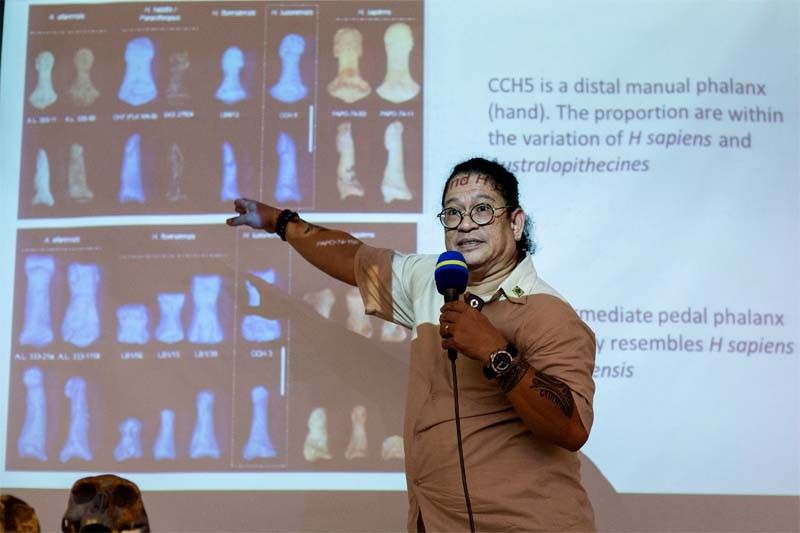‘Man who dug deeper’: UP professor leads discovery of ‘Homo luzonensis’

MANILA, Philippines — After almost two decades of digging deep into the wonders of Luzon, Filipino archaeologist Armand Salvador Mijares made history after leading a team of researchers that discovered a new species of ancient human in the Philippines.
Mijares, an archaeologist and associate professor at the University of the Philippines Diliman, served as the project leader of the multinational team who unveiled the small-bodied hominin called Homo luzonensis. The hominin is believed to have lived on the island of Luzon around 50,000 to 67,000 years ago.
The landmark discovery was announced in the journal Nature on Wednesday.
READ: Unknown human species that lived 50,000 years ago found in Philippines
Mijares was also the co-author of the study on the Homo luzonensis.
'Callao Man' discoverer
This was not the first time Mijares put the Philippines on the global archaeological map.
In 2007, Mijares also lead a multinational team to discover the earliest fossil evidence of humans in Southeast Asia dubbed “Callao Man.”
According to the provincial government of Cagayan, where Callao Cave is located, the bone discovered by Mijares and his team “was a third metatarsal and one of the bones that make up the middle part of the foot dated almost 67 years old.”
This bone was unveiled to the public in August 2010.
“For a long, long time, the Philippine islands [have] been more or less left [out]," Mijares, told National Geographic about the latest landmark discovery.
It was in 2003 when Mijares first started his archaeological trail and excavated Callao Cave where he found 25,000-year-old evidence of human activity.
The professor and researcher, who is also a National Geographic grantee, is known to specialize in lithic analysis, ceramic petrology, soil micromorphology, early human migration and Palaeolithic Archaeology.
“My research is focused on understanding early human migration in Island Southeast Asia. I am also interested in reconstructing hunter-gatherer subsistence strategy during the Late Pleistocene and Early Holocene period,” Mijares said in his profile on the UP website.
He also spearheads archaeological research on the island of Mindoro in collaboration with other specialists and colleagues, both local and international. He said he established this “in order to reconstruct past human movements.”
UP roots
Mijares started his career in Anthropology and Archaeology in state-run UP, where he graduated Bachelor of Arts in Development Studies in 1988. He also finished a master’s degree in Anthropology at the same university in 1995.
In 1997, Mijares earned a diploma in Archaeology also from UP.
Mijares continued his post-graduate studies in Anthropology and Archeology abroad and earned a master’s degree in Anthropology major in Archaeology (with Distinction) at the University of New Mexico. He subsequently got his PhD in Archaeology and Palaeoanthropology at the Australian National University.
He has taught various courses in UP Diliman including History of Archaeology, Scientific Archaeological Analysis, Philippine Prehistoric Archaeology, Special Topics in Archaeology (Cave Archaeology), Stone Ages and Complex Societies, among others.
In his stay at the UPD, Mijares earned several special awards including the following:
- University of the Philippines Diliman 2008 Centennial Professorial Chair Awards
- University of the Philippines Diliman 2010 Centennial Faculty Grantee Awards
- University of the Philippines Diliman 2011 Centennial Professorial Chair Awards
- University of the Philippines Diliman 2011-2012 University of the Philippines Diliman Centennial Faculty Grantee
- University of the Philippines Diliman 2012 Centennial Faculty Grantee Awards
- University of the Philippines Diliman 2012 University of the Philippines Diliman International Publication Award (Article-ISI)
- University of the Philippines Diliman 2013-2014 Centennial Faculty Grantee Awards
- University of the Philippines Diliman 2014 International Publication Award (Book Chapter)
Mijares’ journals and studies also got published in several publications since 2001.
'Proud Filipino and Southeast Asian'
Amid the long list of Mijares’ recognitions and researches, Mijares found the discovery of Homo luzonensis as one of his legacies in this world. He accomplished this with several other researchers from the Philippines, France and Australia, including professor Philip Piper, his co-author in the new study, who confirmed that the bone found in Callao Cave was human remains.
“I'm very proud, because as a Filipino and Southeast Asian, we tend to be on the periphery of this debate. Now, we can be actively engaged in the debate, because our areas—our sites—are now recognized,” Mijares said in an interview with National Geographic.
“And that is, I guess, my legacy in this world,” he concluded. — with reports from National Geographic
- Latest
- Trending




























